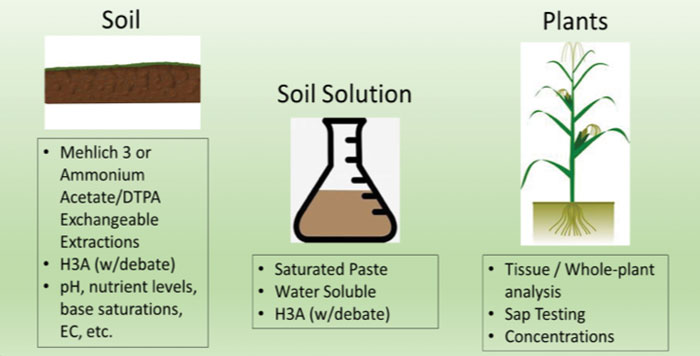Optimal nutrient placement is the top benefit of strip-till in the eyes of Chris Kasten, data analyst for TEVA Corporation. Kasten says determining optimal nutrient rates for the crop comes down to 3 basic steps:
- Determine soil contribution to the crop (soil test)
- Determine input requirements for the crop
- Bridge the gap
When assessing the soil contribution to the crop through soil tests, Kasten considers these 8 important factors to increase nutrient uptake efficiency:
1. Traditional Soil Math Does Not Apply to Strip-Till
The traditional soil math that growers are used to hearing about is not meant to apply to strip-till, says Kasten. He calculates that approximately 40% of an acre is utilized by corn in a strip-till system with 30-inch rows.
“This changes your interpretation of the data,” Kasten says. “Strip-till math is different because you’re not dealing with the entire acre. With only 40% of the surface area per acre being utilized by corn, 1 ppm on the soil test now equals 0.8 pounds per acre, not 2 pounds per acre. You’re working with much less because the roots aren’t where most of the soil tests are reading.”
Strip-tillers must test with a purpose, Kasten adds, keeping in mind that the feeding zone of a corn plant is 3 inches from each side of the stalk. Nutrient recovery drops significantly with every inch outside of that 6-inch zone.
“With soil tests, I’m testing 4-inch slices, both in the band and in the middles, which were last year’s bands,” Kasten says. “I’m looking at where nutrients go after application. I’m testing before the application, and I’m testing after the application. Test with a purpose. Too often you just have a binder full of soil tests, and you never use them. They’re useful all year and every year.”
2. Fertilize for Production, Not Removal
Kasten believes the following nutrient requirements are accurate for a healthy corn crop:
- Nitrogen (N): 0.7-1.2 pounds per bushel
- Phosphorous (P): 0.3-0.5 pounds per bushel
- Potassium (K): 1-1.2 pounds per bushel
- Sulfur: 0.10-0.15 pounds per bushel
“You need way more K than P,” Kasten says. “P gets chemically tied up in your soil, whereas K gets physically tied up. Overapplication is the predominant issue with N, but you can’t plan to fail, so I understand the conundrum. You can’t underapply N because that would be foolish, but you can overapply and create protein issues and nutrient acquisition issues. You can test for that, though.”
Following the strip-till math, Kasten says if a soil test shows 92 pounds of available P, it would mean there are 36 pounds (40% of 92) available. Looking at the above nutrient rates, 250-bushel corn would require 125 pounds of P. To bridge the gap and reach the 125-pound mark, the strip-tiller would need to apply about 90 pounds of P.
3. You Don’t Need Less Fertilizer Because You Strip-Till
Kasten encourages strip-tillers to fertilize the crop based on its needs.
“Don’t cut yourself below your feeding potential just because of placement,” he says. “Placement is your benefit — don’t screw it up by not putting enough fertilizer in there. If you’re fertilizing for crop needs, strip-tilling provides better nutrient recovery. Mathematically, you’d need to broadcast approximately 5 times the quantity of strip-placed fertilizers to get the same quantity to the crop.”

TESTING METHODS. Soil, soil solution and plants are 3 things strip-tillers might test. Soil solution testing isn’t as common, but Kasten says it’s growing in popularity because it produces useful data. Mehlich 3 is the test Kasten uses most often because it’s the cheapest option. “Mehlich 3 designed for lab efficiency, which equates to cheaper sampling for you,” he says. Image: Chris Kasten
4. Every 100 Pounds of Broadcast Fertilizer = 1 Gram Per Square Foot
“What does a square foot of soil represent if you add depth to it at 6 inches? About 45 pounds,” Kasten says. “And you’re putting 1 gram on top of it — the weight of a small paperclip. It’s amazing what we can do with so little, but it’s also so wasteful because we could concentrate that.
“With strip-till, you’re fertilizing the strip, so you can take advantage of that. With some nutrients like sulfur and K, you might get some movement with water into the strip, but the corn plant can’t reach out and get the fertilizer outside of its feeding zone.”
5. CEC is Not “Holding Capacity”
Kasten emphasizes that CEC (cation exchange capacity) does not mean holding capacity, as it’s traditionally marketed.
“I have a library of over 200 agronomy books going all the way back to the late 1800s,” Kasten says. “CEC, when it was brought about, was referred to as holding capacity, and that has stuck. CEC is a calculated number. It’s the combination of that line on your samples — it’s the calcium, magnesium, K, sodium and hydrogen that creates CEC.”
CEC is calculated based on the quantity of nutrients registered and analyzed on the soil test, Kasten says, reminding strip-tillers that strip-till math applies to CEC as well. If the CEC number is 10 on the soil test, but you’re strip-tilling in 30-inch rows and only working with 40% of the soil, then the number is really 4.
“The roots aren’t where most of the soil tests are reading…”
“CEC is flexible, and I can manipulate percentages and ratios in a 4 CEC immensely faster than I can a 10,” Kasten says. “Applications of any sort of product on a 4 CEC would radically change the CEC more than it would a 10 CEC. The ratio of the product to the soil changes dramatically because you’re not working with as much soil.”
Kasten also reminds strip-tillers to pay attention to their nutrient levels to avoid antagonisms. Having too much or too little of a certain nutrient could negatively impact other key nutrients. For example, higher magnesium levels will have a negative impact on N, P, K and calcium, Kasten says.
6. Exchangeable Nutrient Levels Are Not Available All at Once
A soil test might show total exchangeable nutrient levels, but keep in mind that only a portion of those exchangeable nutrients are available through time, Kasten says.
“The slowly available pool and the soil solution quantities are very different,” Kasten says. “This explains why you might scratch your head like, ‘I’ve got all this K, why can’t I get it to the crop?’ We must interpret our tests correctly because everyone has different problems.”
7. Your Crops Don’t Care What Your Soil Tests Say
At the end of the day, it’s the grower’s interpretation of the test that truly matters.
“Although my eye is on the nutrient levels, I care more about monitoring fluctuations, like how rainfall patterns impact the movement of nutrients.” Kasten says. “I’m also testing the middles because I want to compare them to the strip. Where are the nutrients moving in the band? There are all these interplays at work of plant physiology, soil science, chemistry and climate. You’re trying to run a Wal-Mart without a roof on it. There’s only so much you’re in control over, but some of it is nutritional, and tests help you control that.”
8. Don’t Compare Tissue Results From Plants With Different Weights

SIZE MATTERS. Plants that weigh less (DM stands for dry matter) can have deceptively high nutrient readings in a test, as illustrated in this comparison of corn and soybean tissue samples. The highlighted numbers represent higher nutrient level readings, which are more prominent on the lower yielding plants that weighed less. Image: Chris Kasten
There’s a relationship between yield and weight, Kasten says. With this in mind, he encourages strip-tillers to dive deeper into their tissue test results. If a tissue test shows a high P level in a corn plant, it doesn’t necessarily mean the plant isn’t P-deficient.
“A corn plant that has a P deficiency will be a smaller plant, and a smaller plant equals a higher tissue sample reading,” Kasten says. “Smaller plants can have a deceptively high tissue concentration, but if you don’t have the weight behind it, you will not have the yield coming off it. You may have a P deficiency and not even know it.”







